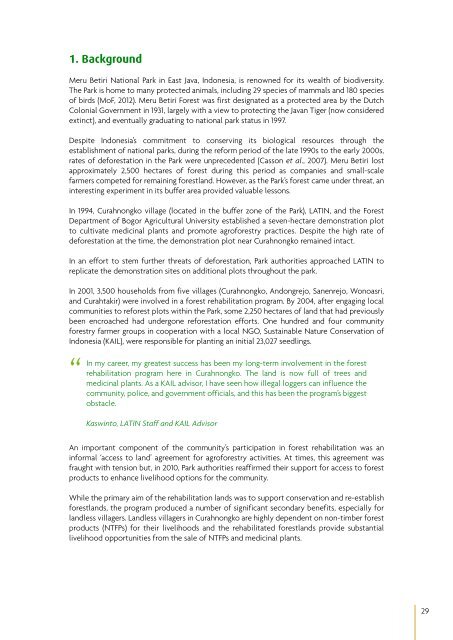Adaptation case studies.pdf - RECOFTC
Adaptation case studies.pdf - RECOFTC
Adaptation case studies.pdf - RECOFTC
Create successful ePaper yourself
Turn your PDF publications into a flip-book with our unique Google optimized e-Paper software.
1. BackgroundMeru Betiri National Park in East Java, Indonesia, is renowned for its wealth of biodiversity.The Park is home to many protected animals, including 29 species of mammals and 180 speciesof birds (MoF, 2012). Meru Betiri Forest was first designated as a protected area by the DutchColonial Government in 1931, largely with a view to protecting the Javan Tiger (now consideredextinct), and eventually graduating to national park status in 1997.Despite Indonesia’s commitment to conserving its biological resources through theestablishment of national parks, during the reform period of the late 1990s to the early 2000s,rates of deforestation in the Park were unprecedented (Casson et al., 2007). Meru Betiri lostapproximately 2,500 hectares of forest during this period as companies and small-scalefarmers competed for remaining forestland. However, as the Park’s forest came under threat, aninteresting experiment in its buffer area provided valuable lessons.In 1994, Curahnongko village (located in the buffer zone of the Park), LATIN, and the ForestDepartment of Bogor Agricultural University established a seven-hectare demonstration plotto cultivate medicinal plants and promote agroforestry practices. Despite the high rate ofdeforestation at the time, the demonstration plot near Curahnongko remained intact.In an effort to stem further threats of deforestation, Park authorities approached LATIN toreplicate the demonstration sites on additional plots throughout the park.In 2001, 3,500 households from five villages (Curahnongko, Andongrejo, Sanenrejo, Wonoasri,and Curahtakir) were involved in a forest rehabilitation program. By 2004, after engaging localcommunities to reforest plots within the Park, some 2,250 hectares of land that had previouslybeen encroached had undergone reforestation efforts. One hundred and four communityforestry farmer groups in cooperation with a local NGO, Sustainable Nature Conservation ofIndonesia (KAIL), were responsible for planting an initial 23,027 seedlings.“In my career, my greatest success has been my long-term involvement in the forestrehabilitation program here in Curahnongko. The land is now full of trees andmedicinal plants. As a KAIL advisor, I have seen how illegal loggers can influence thecommunity, police, and government officials, and this has been the program’s biggestobstacle.Kaswinto, LATIN Staff and KAIL AdvisorAn important component of the community’s participation in forest rehabilitation was aninformal ‘access to land’ agreement for agroforestry activities. At times, this agreement wasfraught with tension but, in 2010, Park authorities reaffirmed their support for access to forestproducts to enhance livelihood options for the community.While the primary aim of the rehabilitation lands was to support conservation and re-establishforestlands, the program produced a number of significant secondary benefits, especially forlandless villagers. Landless villagers in Curahnongko are highly dependent on non-timber forestproducts (NTFPs) for their livelihoods and the rehabilitated forestlands provide substantiallivelihood opportunities from the sale of NTFPs and medicinal plants.29
















